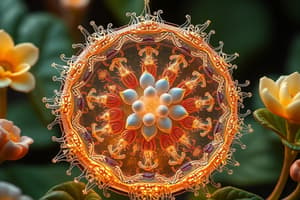Podcast
Questions and Answers
What is the main function of root hair cells?
What is the main function of root hair cells?
- To transport water to the leaves
- To absorb water from the soil (correct)
- To create energy through cellular respiration
- To perform photosynthesis
The shoot system is responsible for water absorption in plants.
The shoot system is responsible for water absorption in plants.
False (B)
What is the primary function of palisade mesophyll cells?
What is the primary function of palisade mesophyll cells?
To perform photosynthesis
Root hair cells absorb water primarily through a process called ___________________.
Root hair cells absorb water primarily through a process called ___________________.
What is the advantage of the elongated structure of root hair cells?
What is the advantage of the elongated structure of root hair cells?
The upper epidermis of the leaf is responsible for photosynthesis.
The upper epidermis of the leaf is responsible for photosynthesis.
Match the following plant systems with their functions:
Match the following plant systems with their functions:
What structure in palisade mesophyll cells allows them to perform photosynthesis?
What structure in palisade mesophyll cells allows them to perform photosynthesis?
What is the main function of the waxy layer on the cells of the upper epidermis?
What is the main function of the waxy layer on the cells of the upper epidermis?
Palisade mesophyll cells have thick cell walls that prevent light penetration.
Palisade mesophyll cells have thick cell walls that prevent light penetration.
What is the primary reason why palisade mesophyll cells are optimal for photosynthesis?
What is the primary reason why palisade mesophyll cells are optimal for photosynthesis?
The waxy layer, known as the _____, on the cells of the upper epidermis acts as a waterproof barrier.
The waxy layer, known as the _____, on the cells of the upper epidermis acts as a waterproof barrier.
Match the following structures with their functions:
Match the following structures with their functions:
What is the primary factor that influences the opening and closing of stomata?
What is the primary factor that influences the opening and closing of stomata?
Guard cells are found in the upper epidermis layer.
Guard cells are found in the upper epidermis layer.
What is the primary function of stomata in plant leaves?
What is the primary function of stomata in plant leaves?
What is the dominant pigment in chloroplasts?
What is the dominant pigment in chloroplasts?
The light-independent stage of photosynthesis occurs in the thylakoid membranes.
The light-independent stage of photosynthesis occurs in the thylakoid membranes.
What is the byproduct of photosynthesis that is released by the plant during the light-dependent stage?
What is the byproduct of photosynthesis that is released by the plant during the light-dependent stage?
The light-dependent stage of photosynthesis results in the formation of ______________________ and 'loaded' acceptor molecules, NADP.
The light-dependent stage of photosynthesis results in the formation of ______________________ and 'loaded' acceptor molecules, NADP.
Match the following components of the chloroplast structure with their descriptions.
Match the following components of the chloroplast structure with their descriptions.
What is the effect of increasing temperature on the rate of photosynthesis?
What is the effect of increasing temperature on the rate of photosynthesis?
Photosynthesis occurs all the time.
Photosynthesis occurs all the time.
The light intensity affects the rate of photosynthesis until the enzymes are working at their ______________________ capacity.
The light intensity affects the rate of photosynthesis until the enzymes are working at their ______________________ capacity.
What is the term for the process by which water is broken down into oxygen and hydrogen ions during the light-dependent stage of photosynthesis?
What is the term for the process by which water is broken down into oxygen and hydrogen ions during the light-dependent stage of photosynthesis?
What is the role of carbon dioxide in photosynthesis?
What is the role of carbon dioxide in photosynthesis?
Study Notes
Photosynthesis
- Occurs in chloroplasts
- Uses products of cellular respiration and cellular respiration uses products of photosynthesis
- Equation: Carbon dioxide + water = glucose + oxygen + water
Chloroplast Structure
- Double membrane (inner and outer)
- Thylakoids: disks formed from membranes containing chlorophyll
- Grana: stacks of thylakoids
- Stroma: fluid filled area around grana and inner membrane
- Stromal lamellae: act as structure to keep grana away from each other
Photosynthesis Equation
- 12H2O + 6CO2 → 6O2 + C6H12O6 + 6H2O
- Light energy is required
- Can be simplified to: 6H2O + 6CO2 → C6H12O6 + 6O2
Photosynthesis in Two Stages
- Light-dependent stage:
- Occurs within thylakoid membranes of chloroplasts
- Requires water and light energy
- Produces ATP and NADPH
- Oxygen is released as a byproduct
- Light-independent stage:
- Occurs in the stroma of chloroplasts
- Requires carbon dioxide and products from the light-dependent stage
- Produces glucose
- Equation: 24H+ + 6CO2 → C6H12O6 + 6H2O
Inputs and Outputs of Both Stages
- Light-dependent stage:
- Input: water and light energy
- Output: ATP, NADPH, and oxygen
- Light-independent stage:
- Input: carbon dioxide and products from light-dependent stage
- Output: glucose
Factors Influencing the Rate of Photosynthesis
- Temperature: increases rate of photosynthesis until enzymes are denatured
- Light intensity: increases rate of photosynthesis until enzymes are working at maximum capacity
- CO2: increases rate of photosynthesis until maximum rate is reached
Photosynthesis and Respiration
- Respiration occurs all the time
- Photosynthesis requires light
- Compensation point: where rate of photosynthesis equals rate of respiration
Chloroplasts and Pigments
- Chlorophyll: dominant pigment in chloroplasts
- Reflects green light and absorbs other wavelengths
- Almost all energy from green wavelengths is reflected
Plant Structure and Function
- Plants have specialized cells, tissues, organs, and organ systems
- Three main systems: root system, shoot system, and reproductive system
Root Hair Cells
- Contain hair-like extensions to increase surface area
- Absorb water through osmosis
- Efficient at absorbing water due to elongated structure, thin cell walls, and active transport mechanisms
Palisade Mesophyll Cells
- Located on upper side of leaf below upper epidermis
- Where most photosynthesis occurs
- Contain many chloroplasts
- Tightly packed and close to leaf surface to maximize light absorption
Guard Cells and Stomata
- Stomata: pores in epidermis that allow gas and water vapor exchange
- Guard cells: chloroplast-containing cells that open and close stomata
- Respond to light, opening at daybreak and closing at night
- Also respond to hydration levels, closing when leaf is losing too much water
Studying That Suits You
Use AI to generate personalized quizzes and flashcards to suit your learning preferences.
Description
Learn about the process of photosynthesis, including the equation and reactants, and explore the structure of chloroplasts, including their membranes and components.




